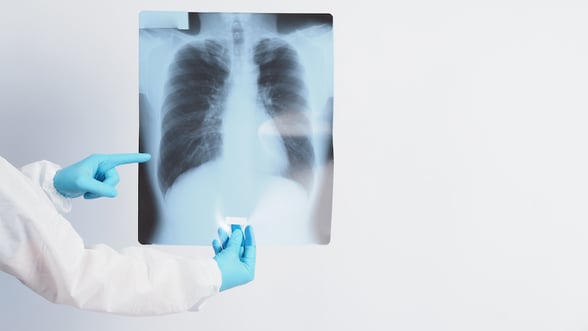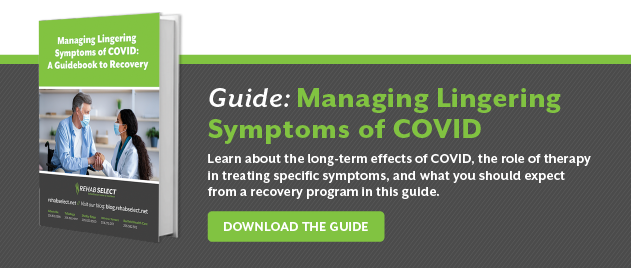
As a respiratory illness, COVID-19 tends to hit the lungs the hardest of all the organs in the body. In fact, lung damage is one of the most common lingering symptoms reported by those who experience long-term effects from COVID-19.
COVID-19 Lung Damage
COVID-19 is a restrictive lung condition, which means it causes difficulties expanding the lungs to full capacity. For some men and women, coronavirus puts major stress on the respiratory system, even more so for those with existing lung conditions, such as asthma or COPD.
In order to understand how the virus damages the respiratory system, it’s helpful to know what exactly happens to your lungs during infection.
What does COVID do to your lungs?
In order to infect your body, droplets containing the virus must enter your body through your eyes, nose, or mouth and make their way down your throat. As infected cells enter your respiratory system, they may cause inflammation or infection in the tiny air sacs in your lungs.
From the onset, coronavirus can cause lung-related symptoms such as shortness of breath or difficulty breathing. Some adults develop pneumonia or acute respiratory distress syndrome, which can further complicate breathing problems.
In some severe cases, the lung damage caused by COVID-19 may persist after the body recovers from the virus. The virus can lead to inflammation, scar tissue, clots, and interstitial lung disease.
This lung damage can leave you with long-term symptoms such as:
- Difficulty breathing
- Shortness of breath
- Chest pain
- Decreased endurance
- Fatigue
The term “long COVID” is used to describe symptoms that persist months after COVID infection, and “long haulers” refers to patients with long COVID.
Fortunately, many COVID long haulers are able to recover from lung damage with rehabilitation treatment, particularly physical therapy. Recovery can take anywhere from a few months to a year or more as the tissues in your lungs heal with the help of a targeted treatment program.
Physical Therapy for COVID Lung Damage
Physical therapy is a vital part of a long-term COVID recovery program. A physical therapist can help you safely reduce the impact of lung damage and build your stamina.
A physical therapy program begins with an initial assessment in which your therapist takes baseline measurements, using tools like capacity testing and musculoskeletal evaluations, to determine your starting point. From there, they build an individualized plan based on your personal impairments to help you make gradual improvements.
You may have multiple physical therapy appointments every week for several months to reach an optimal level of recovery. The sessions include a variety of physical and manual techniques with close monitoring for safety.
Some techniques your physical therapist may use to address lung damage include:
- Airway clearance techniques
- Positional and postural changes to promote fuller breathing
- Breathing exercises and respiratory training
- Respiratory muscle training and stretching
- Manual therapy for stomach expansion
- Endurance exercise
- Resistance training
These therapies can address COVID-19 lung damage in a number of ways, listed below.
1. Physical therapy can address areas of weakness.
After doing a thorough assessment, your therapist can determine which areas of physical capacity you need to work on most. Then, they can formulate a plan to address those specific weaknesses.
For example, let’s say your provider notices weakness in your back muscles that leads to poor posture. This poor posture could contribute to sub-optimal breathing. They can then focus on helping you train those muscles.
As your strength and posture improve through physical therapy, you may notice your breathing gets easier as well. In this way, your therapist can identify and address the areas of weakness that contribute to breathing difficulties.
2. Therapy improves the musculature related to breathing.
When you’re sick, immobilization from hospitalization or prolonged rest can result in muscle atrophy. The muscles related to breathing, such as the abdominals and diaphragm, may be among the muscles that weaken during bed rest.
With targeted exercises and breathing techniques, your therapist can help you address muscle loss and expand your breathing muscles. Abdominal and diaphragmatic breathing techniques, in particular, helps you breathe more fully and increase lung efficiency.
3. Pulmonary rehabilitation improves lung capacity.
One major benefit of physical therapy for the lungs is improved lung capacity. Improving your endurance, muscle strength, breathing, and posture all contribute to better lung capacity.
The targeted training you do makes your body better at expanding your chest and taking in more oxygen with each breath. Rehabilitation helps minimize lung damage, particularly for those in COVID pneumonia recovery. Therapy helps the lungs function more efficiently overall, so you can breathe easier.
4. Therapists teach you how to conserve energy.
Shortness of breath can make simple tasks like walking to the end of the driveway feel taxing. Throughout your recovery, your therapist can help you find ways to prevent fatigue as you gradually resume normal activities.
Your therapist can provide support with mobile aids and assistive devices to help you perform tasks around the house while you recover. They can also teach you energy conservation techniques to minimize fatigue and prioritize your energy for your most important tasks.
5. Therapy sets you up for the best long-term outcomes.
Research suggests early, assertive treatment improves outcomes for similar conditions and likely applies to coronavirus as well. Without treatment, your lungs may maintain below-average function or continue to decline. Targeted treatment, on the other hand, leads to improvements in COVID lung damage.
The main goals of physical therapy are to counteract the negative effects of your health condition and help you return to normal life. The gradual progress you make during therapy helps you improve upon your physical function for the long term.
Find a COVID-19 Rehabilitation Center
Rehab Select has opened COVID-19 recovery programs at their Alabama facilities, working in conjunction with the University of Alabama at Birmingham. They bring together a team of doctors, nurse practitioners, physical and occupational therapists, pulmonologists, psychologists, and other practitioners with COVID-19 experience to create individualized treatment plans for post-COVID recovery.
If you’re looking for rehabilitative care for COVID-19 lung damage in Alabama, contact Rehab Select online or over the phone or click here to schedule a tour.




